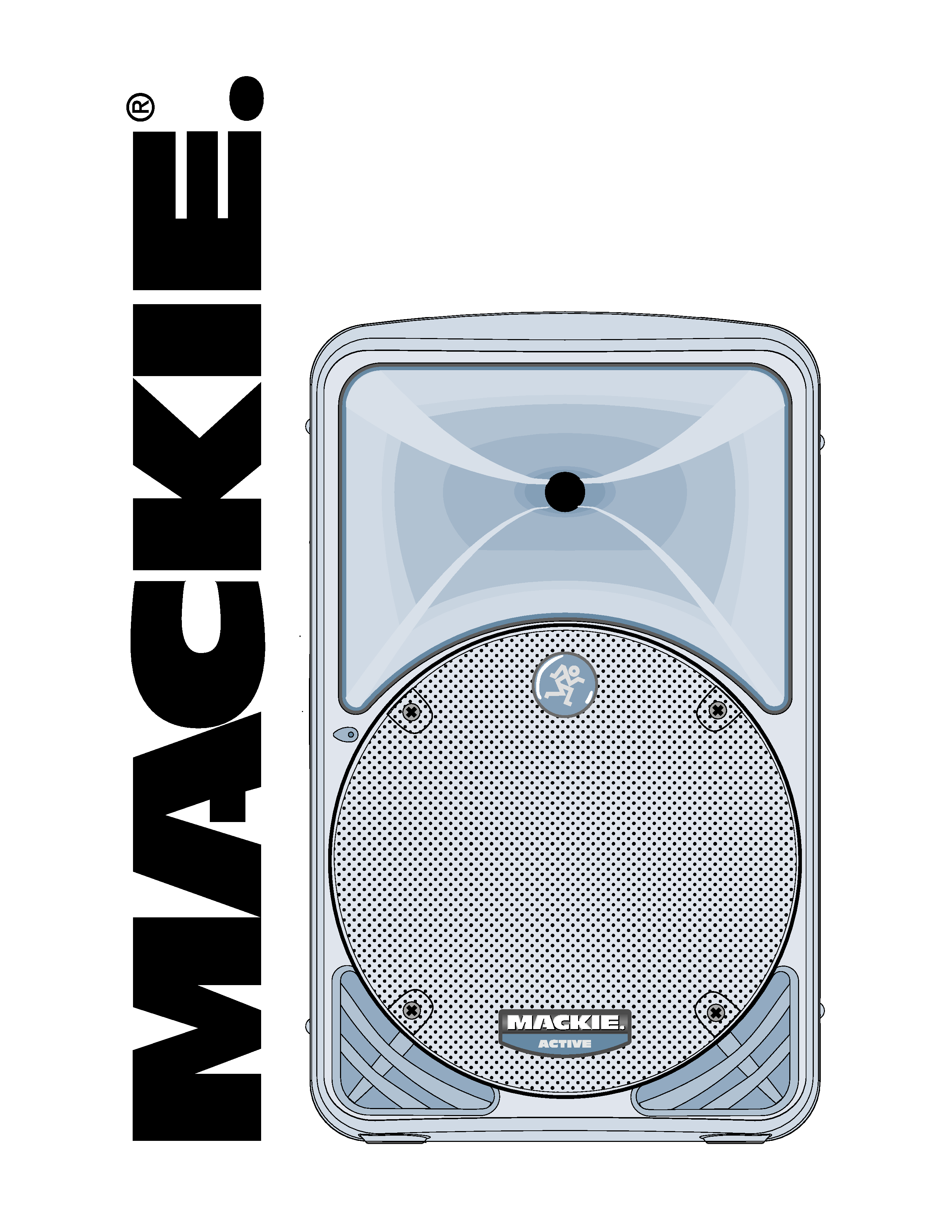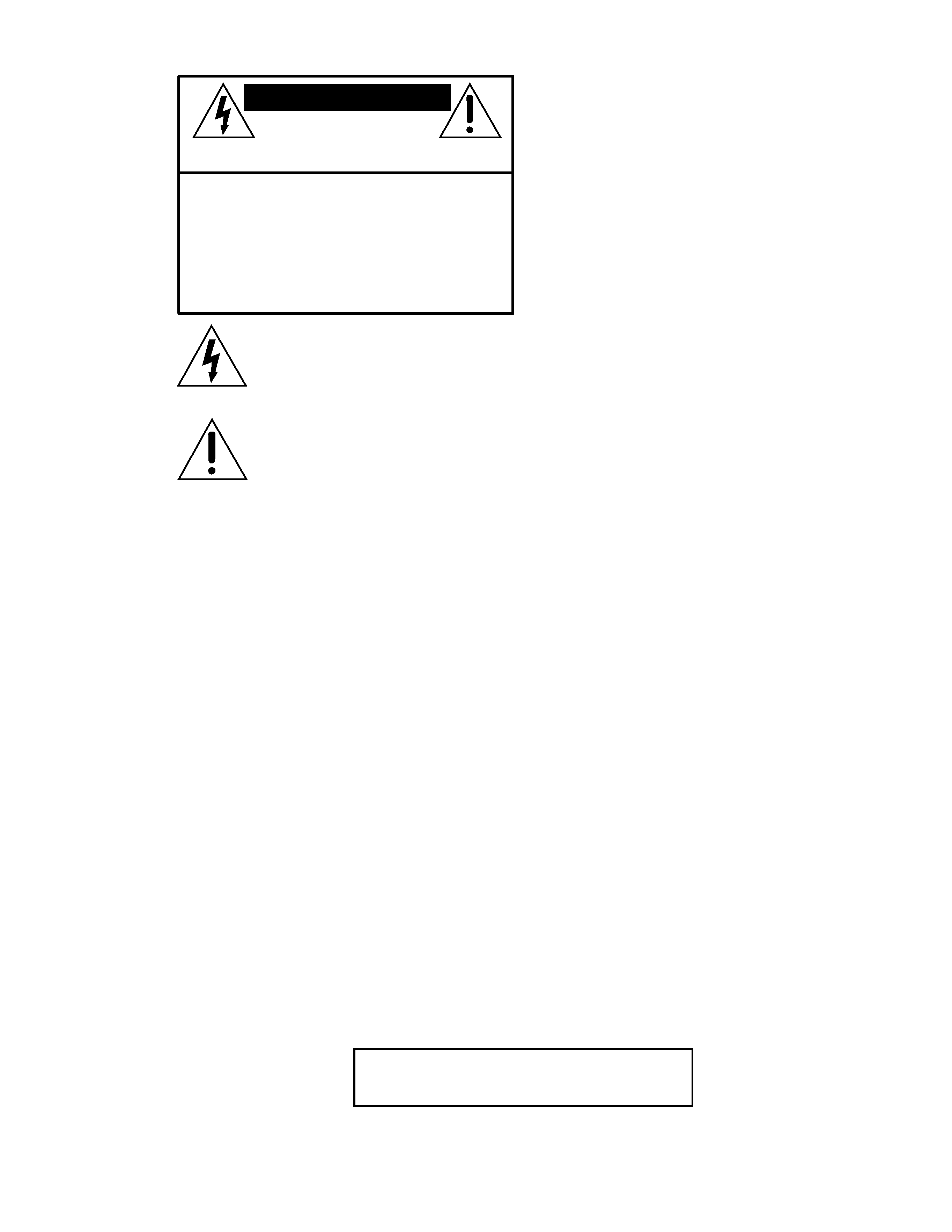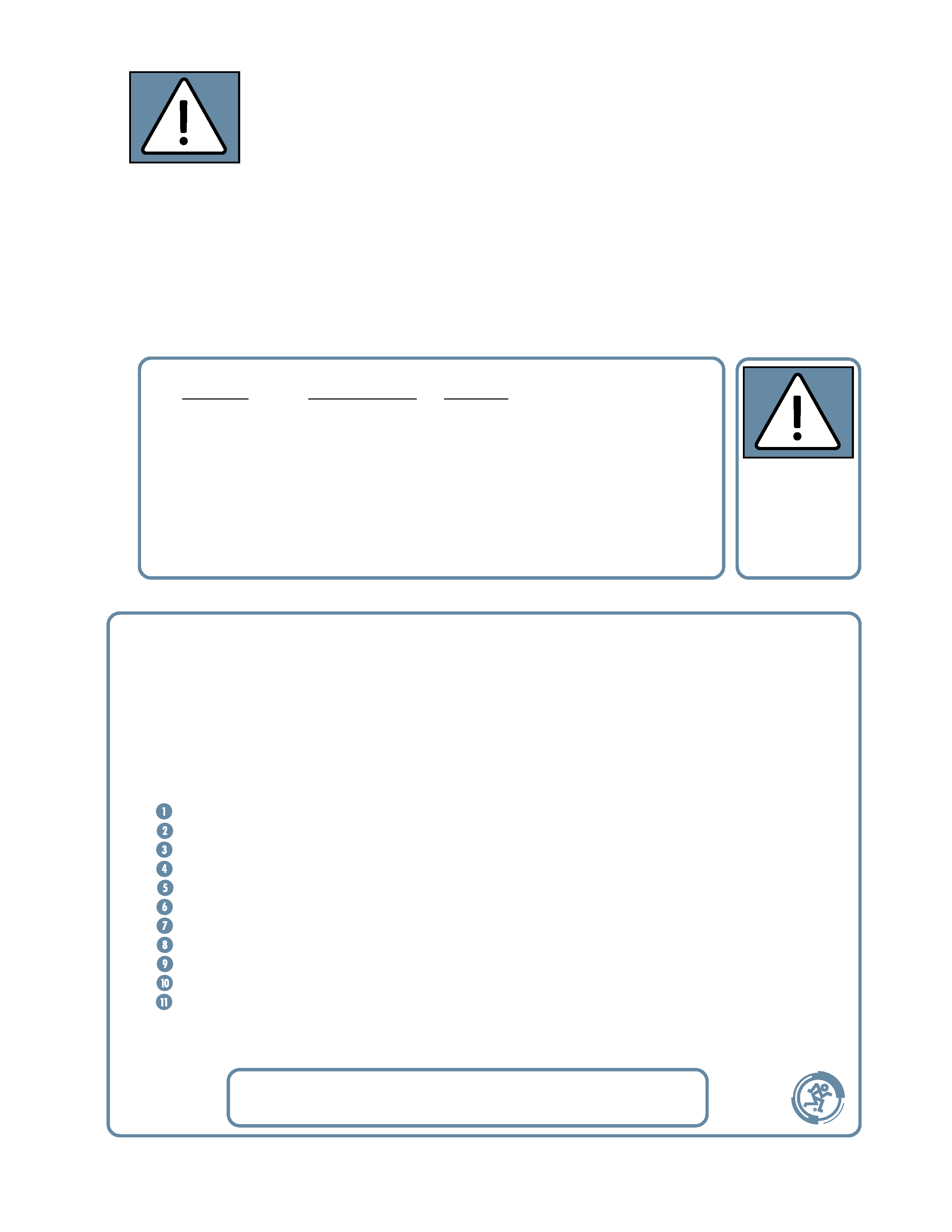
SRM350 2-WAY
ACTIVE LOUDSPEAKER
USER'S MANUAL

2
CAUTION
AVIS
RISK OF ELECTRIC
SHOCK
DO NOT OPEN
RISQUE DE CHOC ELECTRIQUE
NE PAS OUVRIR
CAUTION: TO REDUCE THE RISK OF ELECTRIC SHOCK
DO NOT REMOVE COVER (OR BACK)
NO USER-SERVICEABLE PARTS INSIDE
REFER SERVICING TO QUALIFIED PERSONNEL
ATTENTION: POUR EVITER LES RISQUES DE CHOC
ELECTRIQUE, NE PAS ENLEVER LE COUVERCLE. AUCUN
ENTRETIEN DE PIECES INTERIEURES PAR L'USAGER. CONFIER
L'ENTRETIEN AU PERSONNEL QUALIFIE.
AVIS: POUR EVITER LES RISQUES D'INCENDIE OU
D'ELECTROCUTION, N'EXPOSEZ PAS CET ARTICLE
A LA PLUIE OU A L'HUMIDITE
The lightning flash with arrowhead symbol within an equilateral
triangle is intended to alert the user to the presence of uninsulated
"dangerous voltage" within the product's enclosure that may be
of sufficient magnitude to constitute a risk of electric shock to persons.
Le symbole éclair avec point de flèche à l'intérieur d'un triangle
équilatéral est utilisé pour alerter l'utilisateur de la présence à
l'intérieur du coffret de "voltage dangereux" non isolé d'ampleur
suffisante pour constituer un risque d'éléctrocution.
The exclamation point within an equilateral triangle is intended to
alert the user of the presence of important operating and maintenance
(servicing) instructions in the literature accompanying the appliance.
Le point d'exclamation à l'intérieur d'un triangle équilatéral est
employé pour alerter les utilisateurs de la présence d'instructions
importantes pour le fonctionnement et l'entretien (service) dans le
livret d'instruction accompagnant l'appareil.
9. Power Sources -- This Mackie product should be connected to a
power supply only of the type described in these operation
instructions or as marked on this Mackie product.
10. Power Cord Protection -- Power supply cords should be routed
so that they are not likely to be walked upon or pinched by items
placed upon or against them, paying particular attention to cords at
plugs, convenience receptacles, and the point where they exit this
Mackie product.
11. Object and Liquid Entry -- Care should be taken so that
objects do not fall into and liquids are not spilled into this Mackie
product.
12. Damage Requiring Service -- This Mackie product should be
serviced only by qualified service personnel when:
A. The power-supply cord or the plug has been
damaged; or
B. Objects have fallen, or liquid has spilled into this
Mackie product; or
C. This Mackie product has been exposed to rain; or
D. This Mackie product does not appear to operate
normally or exhibits a marked change in performance;
or
E. This Mackie product has been dropped, or its chassis
damaged.
13. Servicing -- The user should not attempt to service this
Mackie product beyond those means described in this operating
manual. All other servicing should be referred to the Mackie Service
Department.
14. To prevent electric shock, do not use this polarized plug with an
extension cord, receptacle or other outlet unless the blades can be
fully inserted to prevent blade exposure.
Pour prévenir les chocs électriques ne pas utiliser cette fiche
polariseé avec un prolongateur, un prise de courant ou une autre
sortie de courant, sauf si les lames peuvent être insérées à fond
sans laisser aucune pariie à découvert.
15. Grounding or Polarization -- Precautions should be taken so
that the grounding or polarization means of this Mackie product is
not defeated.
16. Power Precaution -- Unplug this Mackie product during
lightning storms or when unused for long periods of time. Note that
this Mackie product is not completely disconnected from the AC
mains service when the power switch is in the OFF position.
17. This apparatus does not exceed the Class A/Class B (whichever
is applicable) limits for radio noise emissions from digital apparatus
as set out in the radio interference regulations of the Canadian
Department of Communications.
ATTENTION --Le présent appareil numérique n'émet pas de bruits
radioélectriques dépassant las limites applicables aux appareils
numériques de class A/de class B (selon le cas) prescrites dans le
règlement sur le brouillage radioélectrique édicté par les ministere
des communications du Canada.
SAFETY INSTRUCTIONS
1. Read Instructions -- All the safety and operation instructions
should be read before this Mackie product is operated.
2. Retain Instructions -- The safety and operating instructions
should be kept for future reference.
3. Heed Warnings -- All warnings on this Mackie product and in
these operating instructions should be followed.
4. Follow Instructions -- All operating and other instructions
should be followed.
5. Water and Moisture -- This Mackie product should not be used
near water for example, near a bathtub, washbowl, kitchen sink,
laundry tub, in a wet basement, near a swimming pool, swamp or
salivating St. Bernard dog, etc.
6. Cleaning -- Clean only with a dry cloth.
7. Ventilation -- This Mackie product should be situated so
that its location or position does not interfere with its proper
ventilation. For example, the Component should not be situated
on a bed, sofa, rug, or similar surface that may block any
ventilation openings, or placed in a built-in installation such as a
bookcase or cabinet that may impede the flow of air through
ventilation openings.
8. Heat -- This Mackie product should be situated away from heat
sources such as radiators, or other devices which produce heat.
WARNING: The heatsink may reach high temperatures during
standard use. To ensure proper operation, allow a minimum of six
inches clearance from the heatsink surface and adequate ventilation.
WARNING -- To reduce the risk of fire or electric
shock, do not expose this appliance to rain or moisture.

3
Part No. 0008034-90 Rev. A 10/03
©2003 LOUD Technologies Inc. All Rights Reserved.
Lend Me Your Ears
Exposure to extremely
high noise levels may
cause permanent hear-
ing loss. Individuals vary
considerably in susceptibility to noise-in-
duced hearing loss, but nearly everyone will
lose some hearing if exposed to sufficiently
intense noise for a period of time. The U.S.
Government's Occupational Safety and
Health Administration (OSHA) has speci-
fied the permissible noise level exposures
shown in this chart.
According to OSHA, any exposure in
excess of these permissible limits could
result in some hearing loss. To ensure
against potentially dangerous exposure to
high sound-pressure levels, it is recommend-
ed that all persons exposed to equipment
capable of producing these levels use hearing
protectors while this unit is in operation.
Ear plugs or protectors in the ear canals or
over the ears must be worn when operating
this amplification system in order to prevent
a permanent hearing loss if exposure is in
excess of the limits set forth here.
Duration Per Day Sound Level dBA,
Typical
In Hours
Slow Response
Example
8
90
Duo in small club
692
4
95
Subway Train
397
2
100
Very loud classical music
1.5
102
1
105
Tami screaming at Adrian about deadlines
0.5
110
0.25 or less
115
Loudest parts at a rock concert
CONTENTS
SAFETY INSTRUCTIONS .......................................... 2
INTRODUCTION ....................................................... 4
HOOKUP DIAGRAMS ............................................... 6
Quick Start ........................................................ 6
REAR PANEL DESCRIPTION .................................... 8
IEC Socket .................................................. 8
POWER Switch ............................................ 8
POWER Indicator ......................................... 8
CONTOUR .................................................. 8
LEVEL ......................................................... 8
MIC/LINE Switch ......................................... 9
SIGNAL Indicator ........................................ 9
LIMIT Indicator ............................................ 9
INPUT Connector ........................................ 9
THRU Connector ......................................... 9
Accessory Plate .......................................... 9
CONNECTIONS ...................................................... 10
PLACEMENT .......................................................... 10
RIGGING ................................................................ 11
THERMAL CONSIDERATIONS ................................ 12
AC POWER CONSIDERATIONS .............................. 12
SERVICE INFORMATION ........................................ 14
Warranty Service ............................................. 14
Troubleshooting ............................................... 14
Repair ............................................................. 16
CARE AND MAINTENANCE .................................... 16
SRM350 SPECIFICATIONS ..................................... 17
SRM350 BLOCK DIAGRAM .................................... 18
SRM350 LIMITED WARRANTY ............................... 19
Don't forget to visit our website at www.mackie.com
for more information about these and other Mackie products.
The SRM350
can produce a
maximum SPL
of 121 dB @ 1m.

4
INTRODUCTION
Thank you for choosing LOUD Technologies'
Mackie active sound reinforcement speakers.
The SRM350 is an active two-way loud-
speaker capable of extremely high sound
pressure levels, and designed to give you the
best performance of any loudspeaker in its
class and price range.
When we designed the SRM350s older
sibling, the SRM450, our goal was to build
a sound reinforcement speaker with the
same fidelity and precision found in our re-
knowned HR824 studio monitors.
Apparently, people liked what they heard.
Now, our goal for the SRM350 is to make
the sound even better with improved active
electronics, but delivered in a more compact
size. We think you'll agree that the SRM350
sound quality and accuracy reaches this
goal and more. The result is a compact
sound reinforcement system equally at
home in a concert setting, in the studio, im-
promptu concerts on the studio roof, in the
cinema, or in a home theater.
The Transducers
The SRM350 active speakers feature a 10
high-power low-frequency woofer and a 1.4
titanium diaphragm high-output precision
compression driver. This high- frequency
driver is mounted on an acoustically non-
resonant exponential waveguide, providing
a wide, controlled dispersion and precise re-
production of the critical upper mid-range
and high frequencies. The result is an unbe-
lievably smooth off-axis response that
allows everyone in the audience to experi-
ence the same high-resolution audio no
matter where they are seated.
Each driver has been specifically designed
by our engineers for optimum performance
in the lightweight high-strength cabinet.
Power Amplifiers
To power these beautiful things, each
SRM350 includes two power amplifiers.
They include the following features:
· The low-frequency amplifier produces
165 continuous watts before clipping.
· The high-frequency amplifier produces
30 continuous watts before clipping.
· Both amplifiers are a Class H design,
which uses a dual power supply for
improved power and thermal efficiency.
The amplifiers operate on the lower
voltage rails until the signal requires
more power, at which point the high
voltage rails seamlessly kick in to
provide additional power.
· An Active Protection Management
System monitors the output levels from
both amplifiers as well as the operating
temperature of the amplifiers. When the
output from either amplifier begins to
clip, a limiter gently reduces the input
signal level until the output is no longer
clipping. Likewise, if the temperature of
either of the amplifers begins to exceed
a safe operating level, the input signal is
elegantly adjusted to keep the tempera-
ture at a desired operating level.
· The low-frequency amplifier also has a
Dynamic Bass Boost circuit. Our ears
are more sensitive to bass frequencies at
high volume levels than at softer vol-
umes. This unique circuit automatically
reduces the low frequencies below 70
Hz as the volume of the speakers goes
up. This results in improved efficiency
for the low-frequency amplifier because
it is not wasting power trying to repro-
duce frequencies we hear better at loud
volumes. Instead, the power is used for
the frequencies where it is needed,
resulting in a louder sound.
Warning: Although the
amplifiers have these
protection circuits, you
must still make sure the
LIMIT
light is not blink-
ing continuously. If it is, turn down your
mixer faders, or preamplifier gain, or turn
down the SRM350 LEVEL control.

5
The Crossover
The built-in electronic crossover is a
24 dB/octave Linkwitz-Riley design. Although
more expensive than other crossover designs,
the benefits provided by the Linkwitz-Riley
design have been well documented. These
benefits include:
· Absolutely flat frequency response
throughout the bandpass, without the
characteristic ripple near the crossover
point exhibited by other designs.
· The sharp 24 dB per octave roll-off of
the filters ensures that the transducers
aren't reproducing frequencies outside
of their capabilities.
· The acoustic sum of the two driver
responses is unity at the crossover
frequency, resulting in perfect power
response.
· Our heroic engineers have worked
carefully to ensure that the SRM350
also provides perfect phase response.
This diligence has yielded phenomenal
accuracy, even if you are standing 20
feet away.
The Cabinet
The SRM350 cabinet was designed to be
the strongest molded composite cabinet on
the planet. This material is as strong as con-
crete, and rigid enough to prevent unwanted
vibrations in the cabinet. An optional acces-
sory plate is available for the top and
bottom of the cabinet to be used for flying,
and a socket in the bottom for mounting on
a tripod stand. Although it is an exceptional
choice for installed sound situations, its
light weight and durable finish also make it
ideal for portable sound system use. The
asymmetrical trapezoidal design of the cabi-
net makes it easy to use as a floor wedge for
stage monitor applications.
The Active Advantage
There are a number of advantages to us-
ing an active speaker system over a passive
loudspeaker:
· The internal crossover is active, and its
low power circuitry operates on line-
level signals. It does not waste
speaker-level power like a passive
crossover with large coils, caps, and
resistors.
· The input signals are crossed over
before they reach the amplifiers, so each
amplifier only receives the correct
frequency range for its driver.
· The amplifiers are designed specifically
for these speaker load impedances.
There is no guesswork as to what load
each amplifier has to drive, so they can
provide maximum acoustic output from
the speakers, yet minimize the danger of
speaker damage due to overdriving a
lesser amplifier.
· The connecting wires between the
amplifier outputs and the drivers are
kept to a minimum, so the damping
factor of the amplifier isn't compro-
mised by the resistance of long speaker
cables. In addition, all the power from
the amplifier is transferred directly to
the drivers with no speaker cable losses.
· The acoustic sum of the outputs from
the two drivers is optimized electroni-
cally, as well as physically, so the
amplitude response is flat and there is
no lobing error.
· The presence of active circuits within
the speaker cabinet allow the designer
to add on extra details, such as a high
quality mic/line input section and
optional accessory modules.
In short, all the complex interconnected
components in the system are designed to
work in harmony with each other to pro-
duce the best possible sound.
